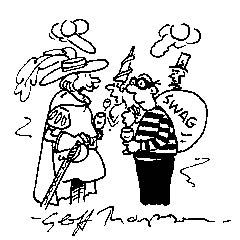‘Bathers at Asnières’ is a dreamily double-edged impressionist painting: an idyll as tricksy as the tiny dots, instead of brushstrokes, that Seurat used to paint. Young Parisian workers are stretched out like cats in the sun, or swimming in water so cool that you can almost feel it, and yet in the background the chimneys puff away, calling them back to work. At the National Gallery the other day, I overheard an official gallery guide addressing a heap of near-comatose teenagers: ‘This is a very large painting,’ she said, ‘and it was painted about 100 years ago.’
In an escape from the shackles of the classroom, as opposed to the factory floor, 80,000 schoolchildren pass through the doors of the National Gallery every year — that’s one potentially excitable child every 15 minutes. But if it is made this much fun, how many of them will return? Why would they? A few rooms away from Seurat, at a cost of £50 million, come September, will be ‘Diana and Actaeon’, the proverbial ‘saved for the nation’ Titian. Perhaps this will be presented as a medium-sized painting, done by an Italian.
Everywhere I looked younger school parties were trussed up like luminous lemmings in small yellow cycling jackets to make them visible (glowing in fact) even inside the gallery. When wonks send out Health and Safety officers to pull down snowmen, it’s no surprise that more rigorous investigations (A Good Childhood, published last month, the Kids in Museums campaign fronted by Mariella Frostrup, and the damning Cambridge Review of Primary Education) have concluded that it’s not much fun growing up these days.
Near Seurat, next to an endlessly mysterious (and sexy) Tintoretto, I found a baffling direction to consider the 150th anniversary of Darwin’s Origin of the Species. ‘Tintoretto’s painting represents a fantastical legend in which the milk of the goddess Juno forms the stars of the Milky Way. But what other origin myths are suggested or concealed in this painting?’ Who cares? Forget getting ‘cross-curricular’ — the reverberating buzz word in museums’ education packs — look at that exploding constellation of stars. Look at the colour of the sky! Do you think Juno is, dare we say the word, beautiful?
It makes me long for that educational anti-heroine Miss Jean Brodie who capriciously asked her charges, ‘Who is the greatest Italian painter?’ ‘Leonardo da Vinci?’ proffers one. ‘No. Giotto. Because he is my favourite.’ Charles Saatchi, when I asked him if he had had any early inspirational encounters, answered that he never went on school trips because he rarely turned up at school. On the other hand, he says, ‘I adored Magritte when I was 14.Went off him when I imagined myself discerning at 17. Then love at first sight with Pollock at the Museum of Modern Art, New York, at 20. Now that I have reverted to childhood, I love Magritte all over again.’ Learning to find favourites, not just gathering a string of visually aided facts, is perhaps the most important art history lesson of all. Providing you are not put off, looking at art can be an education that carries on your whole life.
‘Beauty is truth, truth beauty, — that is all/ Ye know on earth, and all ye need to know…’ It’s of course unfashionable to talk about truth and beauty but it’s not just a sentimental, impractical humanist fixation, or an anomalous throwback to Keats. The poet after all wrote ‘Ode on a Grecian Urn’ about getting excited about an object in the British Museum. Clearly he didn’t have to sit through some dreary talk about its size and age. ‘Understanding has become more important than appreciating,’ says the latterday urn-making, Turner Prize-winning artist Grayson Perry.
‘Why is it a good painting? What do you like about it? Why? Why does it make you feel like that? It fills my heart with sadness that these questions aren’t the ones that are asked of children because we are producing a generation that has no trust in their own intuitive feelings. Children need to be encouraged to start thinking and valuing things in a visceral and emotional way,’ he argues.
Today’s schoolchildren are more likely to be drawing empathetic speech bubbles than to be looking on in wonder. Online, the National Gallery’s kits for teachers show how very far they have come from the ‘visceral’. Monet’s ‘The Water-Lily Pond’ is an excuse for a lesson in engineering; ‘compare ornamental bridges with industrial ones’ is one teaching instruction. With this approach, presumably ‘The Raft of Medusa’ offers lessons in boat-building. It’s deeply depressing to find that the values of New Labour’s ‘education, education, education’ policy, condemned last month by Sir Robin Alexander’s review as ‘severely utilitarian and philistine’, have gone to the core of the education programmes of publicly funded galleries.
At the Tate Modern, that monument to Cool Britannia (at the opening of which Tony Blair told Ian McEwan that he had several of his works hanging on the wall), computer games with fat green ticks and fearsome red crosses provide a quiz where, as if they haven’t had enough of it in the classroom, kids can be tested on works they’ve seen. In one particularly woeful example, inspired by ‘Merda d’artista’ by the Italian conceptual joker Piero Manzoni (bought by the Tate in 2000), you move a bucket around the screen, totting up a score for catching his materials. ‘Fill the cans with Manzoni’s poo’ reads the cheerful instruction. When I was there, one young visitor had given up on all this, and was perched in a booth, watching an episode of South Park on her handheld.
Over at the V&A, the legions of school-kids don’t tend to linger, soaking up the spectacular gothic oddity of the place, but proceed straight to the spick-spock Sackler Wing, to design ‘brands’, launch imaginary product lines and make film clips. The shadowy rooms of Rodin and Dante Gabriel Rossetti (Miss Brodie’s other favourite painter) are a sideshow. While no one can doubt the difficulty of attracting (and holding) the attention of the Facebook i-generation, there are many ways to make a museum boring. One is to describe things as large and old, but another is to turn it into something ordinary in its uniform funkiness: a primary-coloured landscape Grayson Perry terms ‘museum-land’.
In spite of the grim gizmos, the galleries of the Tate Modern are full of teenagers — on their own, not just coerced on school trips. Interestingly, its consultation with 3,000 of them, the Manifesto for a Creative Britain, anticipated the criticism of teaching in the Cambridge Review, with participants lobbying for ‘more creativity in the classroom’ and changes to the curriculum ‘so that our subjects reflect our lives’.
As Charles Handy argued in The Hungry Spirit, the point of access to the arts, particularly when it is free, is ‘a taste of the sublime’ — something you can’t put a price on. Crackpot agreements (many of them hammered out to justify free admission) have museums pledged to connect creativity and entrepreneurship. The National Gallery is tenuously pledged to stimulate ‘the creative industries’, as ‘art collections provide an invaluable resource to a wide range of groups who then go on to generate business and investment opportunities for the nation as a whole’. It has a contractual undertaking to ‘promote prosperity’ — words that it has to be said ring particularly hollow at the mo ment.
The Olympics are already placing pressure on funding for arts and in the current climate this can only get worse. Details of spending by the most important of the national museums obtained by shadow culture secretary Jeremy Hunt shows that spending on acquisitions fell by more than £10 million in 2007/08. The landscape has altered. In 2007, those demon bankers Lehman Brothers supported arts organisations all over the world to the tune of $39 million. They were a principal sponsor of every major museum in London. As museums take stock, perhaps it’s time to re-establish that far from a kooky long-term market investment, or an extra outpost for the half-hearted application of Gradgrindian principles, it’s countering imaginative impoverishment that is their unique selling point.






Comments